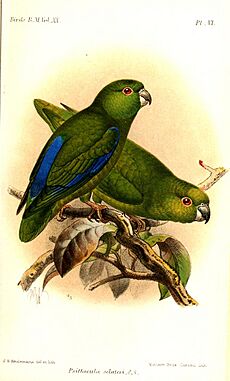Dusky-billed parrotlet facts for kids
Quick facts for kids Dusky-billed parrotlet |
|
|---|---|
 |
|
| At Alta Floresta, Mato Grosso State, Brazil | |
| Conservation status | |
| Scientific classification | |
| Genus: |
Forpus
|
| Species: |
modestus
|
| Subspecies | |
|
|
 |
|
| Synonyms | |
|
|
The dusky-billed parrotlet (Forpus modestus), also known as Sclater's parrotlet, is a small type of parrot. It belongs to the parrot family, Psittacidae. This bird is the main type, or nominate species, called F. m. modestus.
There is one other type, or subspecies, of this parrotlet: Forpus modestus sclateri.
Contents
Meet the Dusky-billed Parrotlet
Dusky-billed parrotlets are small, green birds. They are usually about 12 to 12.5 centimeters (around 5 inches) long. They weigh about 30 to 35 grams (a little over 1 ounce). Their bodies are mostly dark green to yellow-green. They have dark brown eyes and dark gray feet. The top part of their beak is dark gray, and the bottom part is light peach.
Boy and Girl Parrotlets
Boy and girl dusky-billed parrotlets look a bit different. This is called sexual dimorphism.
- Boys have blue-purple feathers on their lower back, rump, and wings.
- Girls do not have any blue markings. Their forehead, top of the head, and cheeks are a brighter yellow-green.
Like all parrots, these birds have special feet called zygodactyl feet. This means two of their toes point forward and two point backward. This helps them grip branches and climb. Young parrotlets look like the adults, but their colors are not as bright. Young males have some green feathers mixed in with their blue markings.
Two Types of Dusky-billed Parrotlets
There are two main types of dusky-billed parrotlets:
- The Dusky-billed Parrotlet (Forpus modestus modestus): This is the main type. You can find them from Belém, Pará, northern Brazil, west to southeastern Colombia. They also live south to eastern Peru, western Brazil, and northern Bolivia.
- Sclater's Parrotlet (F. m. sclateri): Compared to the main type, the males of this subspecies are a paler green. Their blue markings are also lighter. The females are also paler, especially on their chest. This subspecies lives in French Guiana, western Guyana, eastern and southern Venezuela, and northern Brazil to eastern Colombia.
Where They Live and What They Like
The dusky-billed parrotlet lives in the Amazon Rainforest in South America. You can find them in many places there. They also live in the Andes mountains and the areas near them. They are found near the Amazon River outlet and on Marajo Island.
These parrotlets prefer to live in the edges and clearings of lowland tropical rainforests. They also like areas near rivers (called riparian zones). They can be found in places where forests have grown back after being cut down. Sometimes, they live in savanna areas too. They seem to especially like forests that flood during certain seasons. You won't find them in places higher than about 1,000 meters (3,300 feet) above sea level.
Keeping Them Safe
The dusky-billed parrotlet is listed as a species of "Least Concern" by the IUCN Red List. This means they are not currently in danger of disappearing. We don't know exactly how many there are, but their numbers seem to be steady.
Why They Are Not in Danger
Unlike many other parrots, these birds are not often caught for the pet trade. They are also not greatly affected by deforestation, which is when forests are cut down. There are many protected areas where they live, which helps keep them safe.
How They Behave
Social Life
Outside of their breeding season, dusky-billed parrotlets usually live in groups of up to 100 birds. When it's time to have babies, they are mostly seen in pairs. They are very social birds. You can often spot them in their habitat. They make high-pitched calls or soft wheezing sounds. They make these sounds while flying or when sitting on a branch.
Having Babies
Dusky-billed parrotlets usually have their babies in July. We don't know how many eggs they lay at once (called a clutch). However, their eggs are small, white, and round. They build their nests in holes in trees or similar spots.
What They Eat
The diet of dusky-billed parrotlets is mostly berries and fruits, making up about 90% of what they eat. About 10% of their diet comes from seeds, buds, and blossoms. Sometimes, they also eat grass. Interestingly, they have been seen eating clay. They do this to get important minerals.
Their Scientific Name Story
The dusky-billed parrotlet has had a few different scientific names over time. It was first named Forpus sclateri in 1849. Later, in 1859, it was moved to a different group of birds called Psittacula and named Psittacula modesta. But because the name modesta was already used for other similar birds, it went back to being called F. sclateri.
As of 2006, its official scientific name is Forpus modestus. The subspecies we talked about earlier is F. m. sclateri. Some scientists think that the dusky-billed parrotlet is the oldest type of bird in the Forpus group. This is based on how the different types of birds in this group developed over time.
As Pets
The dusky-billed parrotlet is not a common pet bird. You usually can't find them for sale in the United States. They are also very rare to find as pets in Europe.




